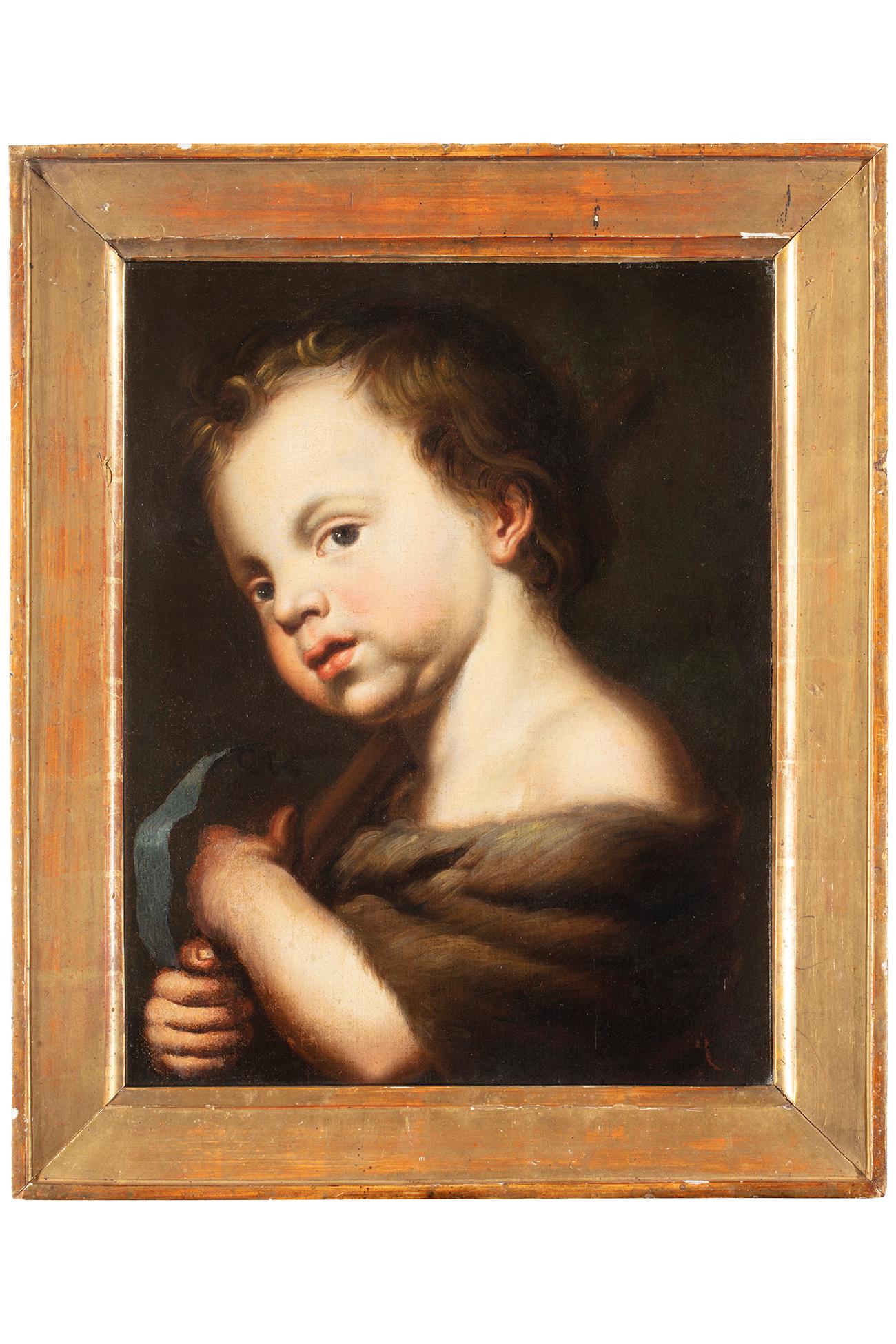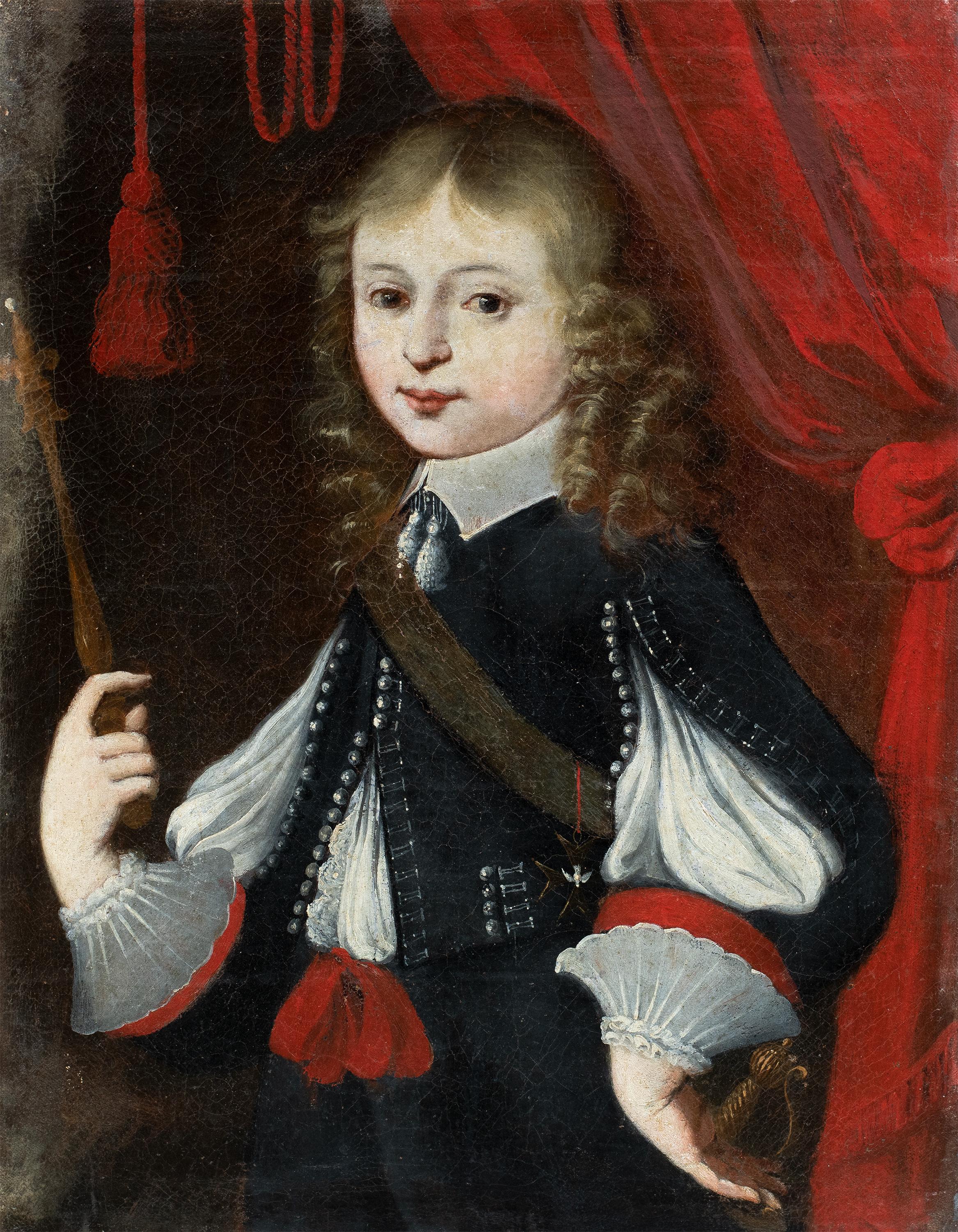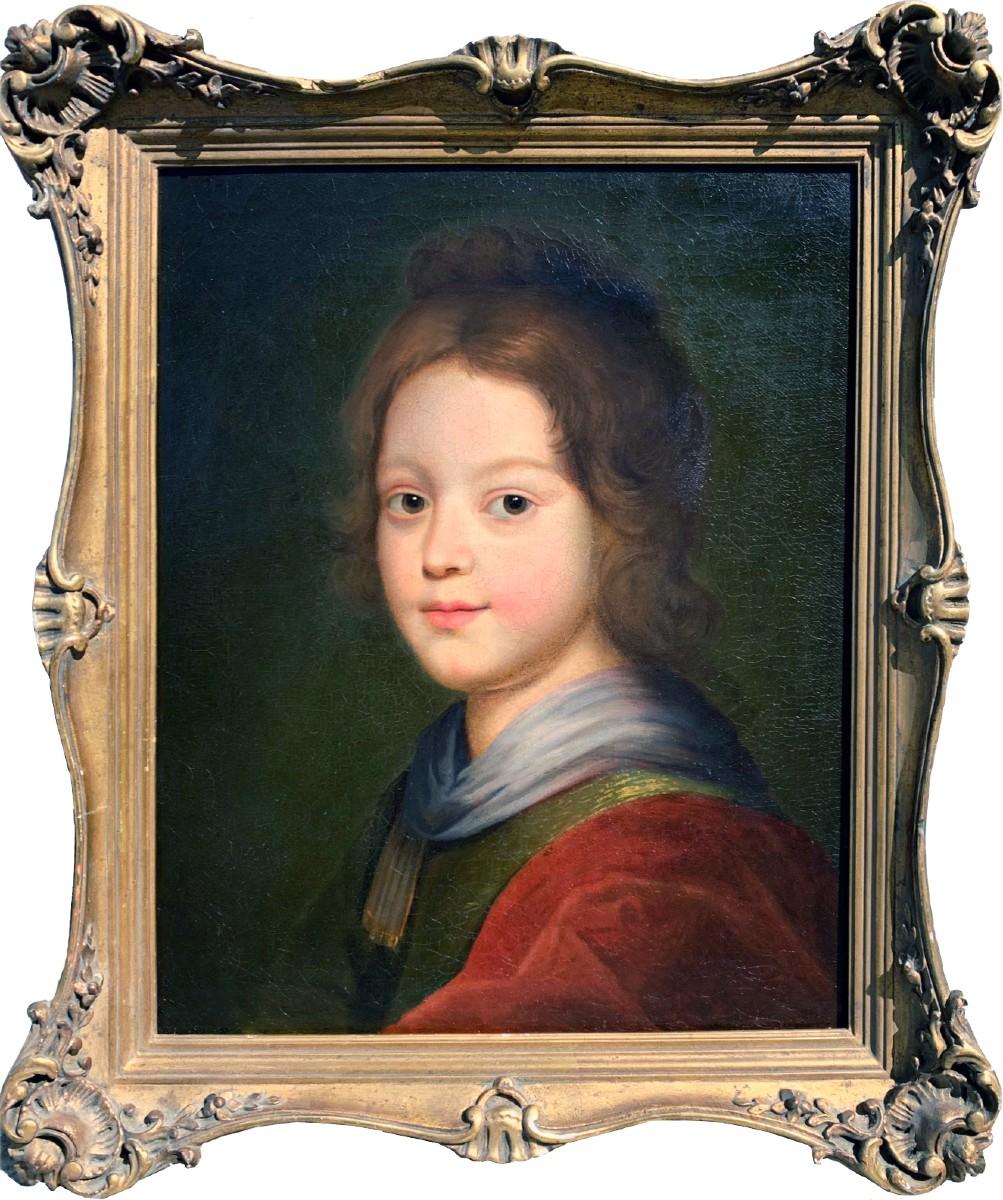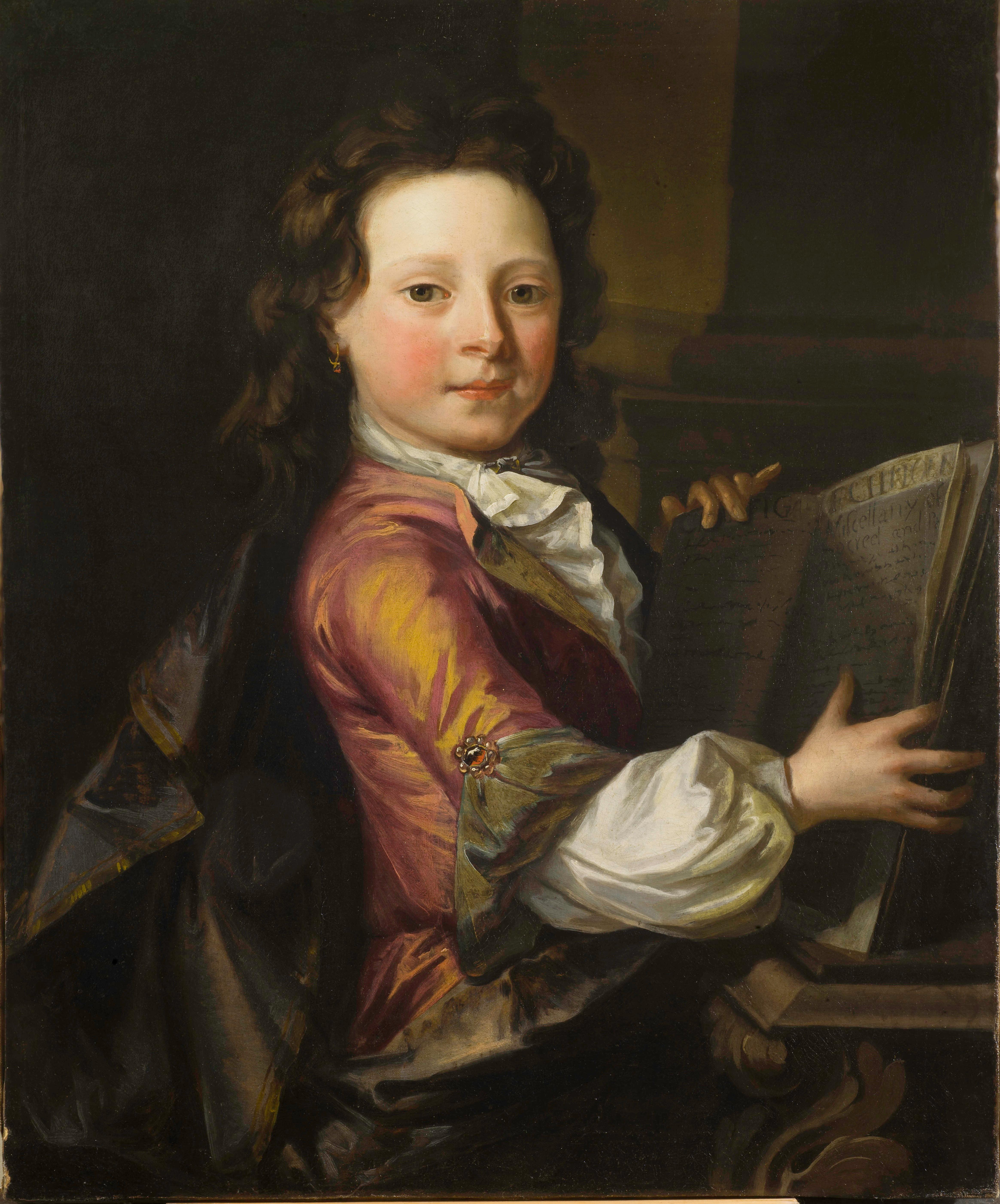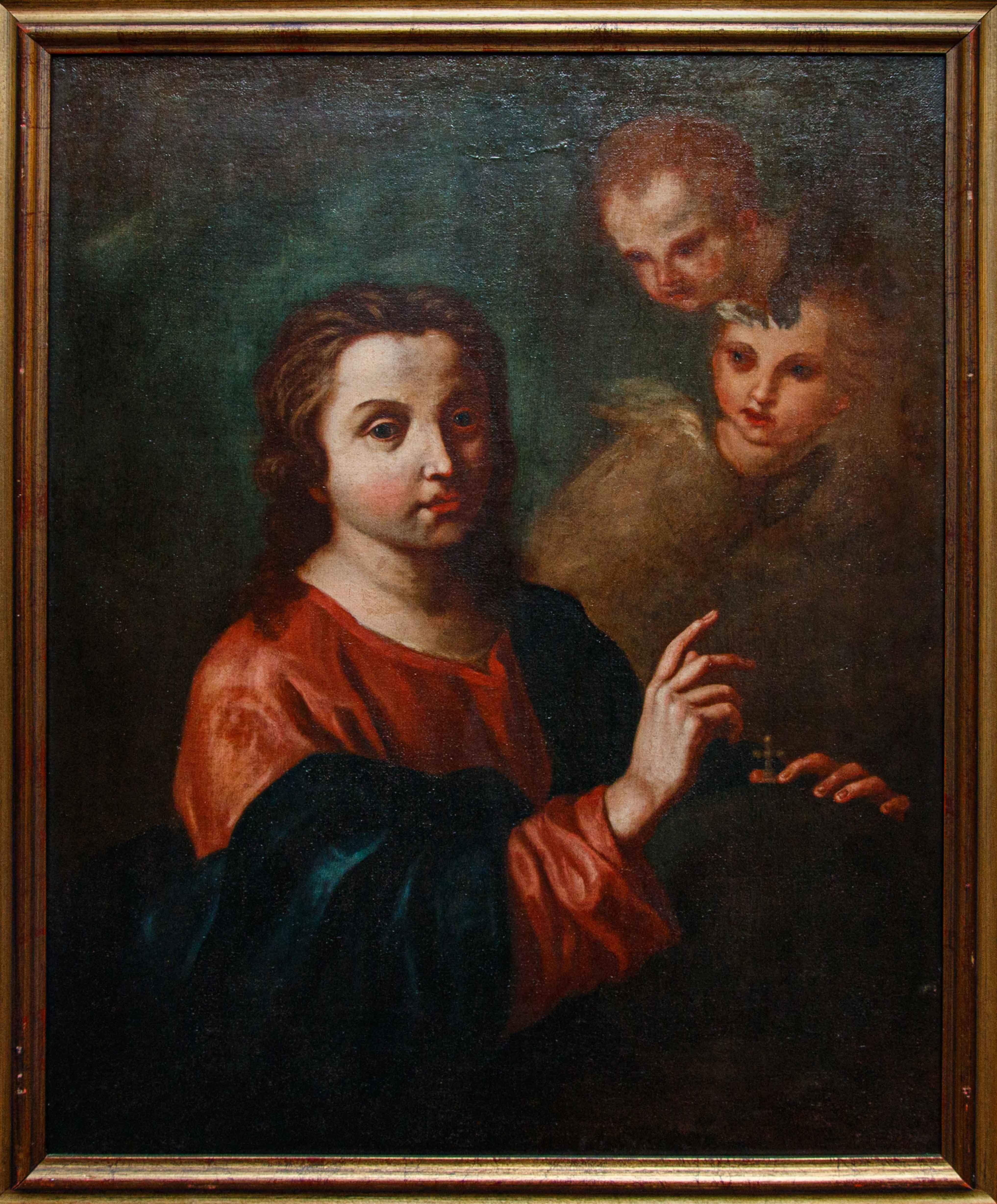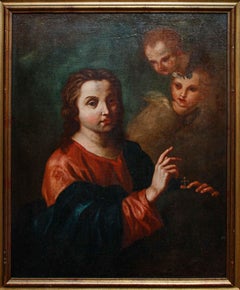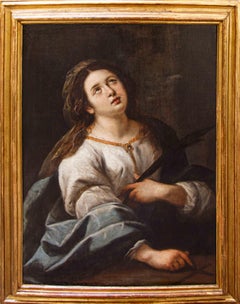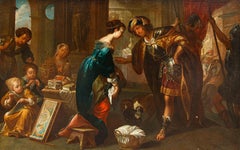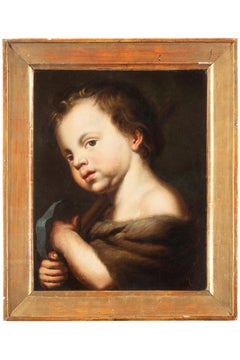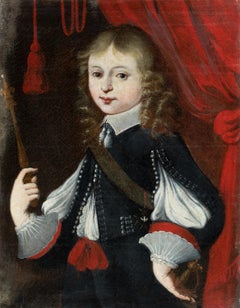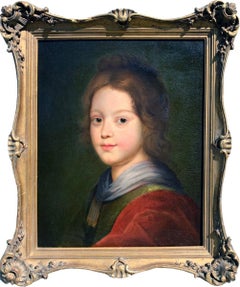Items Similar to Nicolas de Largillière (Paris, 1656 - 1746), Baby Jesus pointing to the cross
Want more images or videos?
Request additional images or videos from the seller
1 of 9
Nicolas de Largillière (Parigi, 1656 – 1746)Nicolas de Largillière (Paris, 1656 - 1746), Baby Jesus pointing to the cross18th 18th Century
18th 18th Century
$11,904.72
£8,840.96
€10,000
CA$16,364.53
A$18,242.10
CHF 9,601.47
MX$221,145.31
NOK 122,244.68
SEK 113,657.95
DKK 76,130.66
About the Item
Nicolas de Largillière (Paris, 1656 - 1746)
Baby Jesus pointing to the cross
Oil on canvas, 60 x 42 cm
Critical Record Prof. Emilio Negro
The painting in question proposes an unusual and, at the same time, fascinating iconographic scheme, that of the Christ child pointing to the cross, the instrument of his martyrdom and prefiguration of his death and resurrection for the redemption of human sins. Baby Jesus addresses the concerning in an almost playful manner: what jumps out at us is the infant's viscous gaze, which interacts directly with the viewer. The depiction of Christ is naturalistic and encyclopedic in nature and clearly shows several references to the northern European tradition of the so-called Golden Age, the 17th century. Because of this characteristic and because of the choice of a light and bright color palette, the work can be ascribed to the corpus of Nicolas de Largillière, a French-born artist trained in Antwerp at the turn of the seventeenth and eighteenth centuries who was well versed in the stylistic features of Nordic painting. Nicolas de Largillière, a Flemish-born French painter, is a key figure in the artistic landscape of the 17th and 18th centuries, celebrated for his lavish portraits and his ability to capture the elegance and grandeur of the aristocracy and bourgeoisie of his time. His long and prolific career saw him witness and interpret the stylistic changes that led from the Baroque to the Rococo, leaving a legacy of works that still captivate today for their vibrancy and refinement. Born in Paris into a family of merchants, Largillière spent his childhood in Antwerp, in the Spanish Netherlands, where his father initially instilled a commercial career. However, his innate inclination for art naturally pushed him toward painting. His training was with Antoine Goubeau, a painter specializing in still lifes and landscapes, who transmitted to him the technical solidity and attention to detail typical of the Flemish school. It was a crucial apprenticeship that provided the foundation for him to develop his distinctive style. Around 1674, Largillière moved to London, where he worked for a few years in the studio of Peter Lely, the leading portrait painter at the court of Charles II. This experience was crucial to his artistic maturation. In contact with Lely, a master in court portraiture, Largillière honed his skill in depicting high-ranking figures, learning to imbue his subjects with a regal grace and dignity. His stay in England also enabled him to appreciate the richness of color and vivid brushwork typical of the English tradition. Returning to Paris in 1679, Largillière quickly established himself as one of the capital's most sought-after portrait painters. His ascent was rapid: in 1686 he was admitted to the Académie Royale de Peinture et de Sculpture and in 1705 became its professor, rising to the position of rector in 1722 and finally director in 1738. These academic awards testify not only to his undisputed mastery, but also to his influential role in shaping the next generation of artists. Largillière's clientele was vast and diverse, including members of the royal family, such as Louis XIV and his successors, the court aristocracy, wealthy bourgeoisie, magistrates, scholars and artists. He excelled in representational portraiture, where his subjects were often depicted in sumptuous clothes, surrounded by symbols of status, and surrounded by elaborate backdrops. His rich, mellow brushwork, brilliant use of color, and ability to render the textures of fabrics and jewelry gave his portraits an extraordinary opulence and vitality. An emblematic example of his style is Largillière's Portrait of the Family (c. 1704), a work that, although a family self-portrait, reveals the same grandeur and attention to detail as his official portraits. The Portrait of Louis XIV (c. 1700) also shows his ability to capture the majesty of the Sun King, infusing the monarch with an aura of power and authority. In addition to the official portraits, Largillière also produced many more intimate and personal portraits, where his sensitivity manifested itself in his ability to capture the psychology of his models. Although portraits are the focus of his production, he also occasionally tried his hand at still lifes, landscapes and historical works, demonstrating remarkable versatility. Largillière was a meticulous artist who devoted great attention to detail and composition. His workshop was renowned for its organization and efficiency, and many young artists trained under his guidance. His influence was lasting and extended to several French painters of the 18th century, who took up and developed his innovations in portraiture. Nicolas de Largillière died in Paris in 1746, at the age of ninety, leaving an impressive artistic legacy and a catalog of more than a thousand works. His long and successful career established him as one of the greatest portrait painters of his era, a master who was able to immortalize the French Golden Age with elegance and splendor, providing us with a precious gallery of faces that still speak to us today of an era of great refinement and magnificence.
The pronounced portraiture connotation of our painting means that it blends seamlessly into De Largillière's corpus: indeed, other similarities can be found with the Portrait of the Countess of Rupelmonde, the Sketch for Head of Child, and the Double Portrait of Prince James Francis Edward Stuart and Princess Louise Marie Theresa Stuart, currently part of the collections of the National Portrait Gallery in London. In particular, the London prince's delicate features closely resemble the likeness of our own baby Jesus pointing to the cross. With our painting, the aforementioned works share the graceful compositional taste of an Italianate nature typical of French painting at the turn of the 17th and 18th centuries and the choice of warm, light and bright colors.
- Creator:Nicolas de Largillière (Parigi, 1656 – 1746) (French)
- Creation Year:18th 18th Century
- Dimensions:Height: 23.63 in (60 cm)Width: 16.54 in (42 cm)
- More Editions & Sizes:cm 60 x 42Price: $11,905
- Medium:
- Period:
- Condition:
- Gallery Location:Milan, IT
- Reference Number:1stDibs: LU2639216764052
About the Seller
No Reviews Yet
Vetted Professional Seller
Every seller passes strict standards for authenticity and reliability
1stDibs seller since 2023
Typical response time: <1 hour
- ShippingRetrieving quote...Shipping from: Milan, Italy
- Return Policy
Authenticity Guarantee
In the unlikely event there’s an issue with an item’s authenticity, contact us within 1 year for a full refund. DetailsMoney-Back Guarantee
If your item is not as described, is damaged in transit, or does not arrive, contact us within 7 days for a full refund. Details24-Hour Cancellation
You have a 24-hour grace period in which to reconsider your purchase, with no questions asked.Vetted Professional Sellers
Our world-class sellers must adhere to strict standards for service and quality, maintaining the integrity of our listings.Price-Match Guarantee
If you find that a seller listed the same item for a lower price elsewhere, we’ll match it.Trusted Global Delivery
Our best-in-class carrier network provides specialized shipping options worldwide, including custom delivery.More From This Seller
View AllCircle of Giovan Battista Piazzetta (1683-1754), Christ Salvator Mundi
By Giovanni Battista Piazzetta
Located in Milan, IT
Circle of Giovan Battista Piazzetta (1683-1754), 18th century
Christ the Savior Mundi
Oil on canvas, 81 x 64 cm
Framed, 90 x 72 cm
This painting is configured within the eighteen...
Category
Early 18th Century Other Art Style Figurative Paintings
Materials
Canvas, Oil
Giuseppe Nuvolone (Milan, 1619 - 1703), Saint in Ecstasy
Located in Milan, IT
Giuseppe Nuvolone (Milan, 1619 - 1703)
Saint in ecstasy
Oil on canvas, 97 x 73 cm
Framed, 113 x 90 cm
Provenance: Rome, private collection
The second son of the famous painter P...
Category
18th Century and Earlier Other Art Style Figurative Paintings
Materials
Canvas, Oil
Paolo De Matteis (Piano Vetrale 1662 - Naples 1728), attr., Dream of Joseph
By Paolo de Matteis
Located in Milan, IT
Paolo De Matteis (Piano Vetrale 1662 - Naples 1728), attr.
Joseph's Dream
Oil on canvas, 49 x 65 cm
Antique Roman frame known as "Maratta," of carved and gilded wood, 61 x 76 cm
...
Category
18th Century Other Art Style Figurative Paintings
Materials
Canvas, Oil
By Jan van den Hecke (Kwaremont, 1620 - Antwerp, 1684), Tarquin and Lucretia
Located in Milan, IT
Monogrammer I.H., identifiable with Jan van den Hecke (Kwaremont, 1620 - Antwerp, 1684)
Sextus Tarquinius surprises Lucretia at work
Oil on canvas, 66 x 100 cm
Framed, 79 x 112 c...
Category
Late 17th Century Other Art Style Figurative Paintings
Materials
Canvas, Oil
Circle of Bartholomeus Breenbergh, Holy Family
By Bartholomeus Breenbergh
Located in Milan, IT
Workshop of Bartholomeus Breenbergh (Deventer, 1598 - Amsterdam, 1657)
Holy Family with San Giovannino
Oil on African marble, 30 x 24 cm
Framed, 45 x 38 cm
The strong emotional i...
Category
17th Century Other Art Style Figurative Paintings
Materials
Marble
Francesco Zucco (Bergamo, c. 1570 - Bergamo, May 3, 1627), Crucifixion
Located in Milan, IT
Francesco Zucco (Bergamo, c. 1570 - Bergamo, May 3, 1627)
Crucifixion with saints
Oil on canvas, 76 x 60 cm
With frame 95 x 79 cm
Critical Record Professor Giuseppe Sava
The cru...
Category
16th Century Other Art Style Figurative Paintings
Materials
Canvas, Oil
You May Also Like
17th Century by Pedro Nunez Portrait of a Child Oil on Canvas
Located in Milano, Lombardia
Pedro Nuñez de Villavicendio (Seville, Spain, 1644 - 1700)
Title: Portrait of a child
Medium: Oil on canvas
Dimensions: without frame 41.5 x 33.5 cm - with frame 52 x 43.5 cm
19th century shaped and gilded wooden frame
Expertise by Didier Bodart, art historian
A Seville painter of noble origins, Pedro Nuñez de Villavicendio (1644-1700), the author of this pretty child portrait, was a Knight of the Order of St John of Jerusalem. He was a pupil of Murillo and, as a Knight of the Order of Malta, worked with Mattia Preti...
Category
Late 17th Century Old Masters Portrait Paintings
Materials
Canvas, Cotton Canvas, Oil
Rococò French painter - 18th century figure painting - Portrait Louis XV child
Located in Varmo, IT
French painter (18th century) - Portrait of Louis XV as a child.
64.5 x 49.5 cm.
Antique oil painting on canvas, without frame (not signed).
Condition report: Lined canvas. Good s...
Category
Early 18th Century Figurative Paintings
Materials
Canvas, Oil
$2,614 Sale Price
21% Off
Free Shipping
18th Century European Portrait of Saint John the Baptist as a Child.
Located in SANTA FE, NM
18th Century European Portrait of a Child Saint John the Baptist
Oil on Canvas
19 x 14 1/4 inches
This lovely and sensitively painting has been examined by a professional restorer w...
Category
18th Century Old Masters Figurative Paintings
Materials
Canvas, Oil
Portrait Enfant Suiveur De Jean Baptiste Greuze (1725/1805 )
By (Circle of) Jean Baptiste Greuze
Located in GOUVIEUX, FR
Huile sur toile Dim avec cadre 50/58 cm Dim sans cadre 37/46 cm Ecole française Suiveur de Jean Baptiste Greuze (1725/1805 ) Elégant portrait d’enfant – Suiveur de Jean-Baptiste Greu...
Category
1790s French School Portrait Paintings
Materials
Canvas
Portrait of a Boy, John Closterman, Large English Portrait Art, Old Master
By John Closterman
Located in Greven, DE
John Clostermann
(Osnabrück 1660 - 1711 London)
Portrait of a boy, maybe Charles Hinde
Oil on canvas, 61 x 74,6 cm
John Closterman (also Klosterman) was a portrait painter of the late 17th and early 18th centuries. He primarily portrayed English noblemen and European aristocratic families. His father was already an artist and he trained his son. In 1679 he went to Paris and studied with Francois de Troy. In 1681 he was in London and worked for the artist John Riley, whose studio he took over after his death. In 1696 he was invited to the Spanish court...
Category
17th Century Baroque Figurative Paintings
Materials
Canvas, Oil
Portrait Child Schedoni 17th Century Paint Oil on canvas Old master
Located in Riva del Garda, IT
Bartolomeo Schedoni (Modena 1578 - Parma 1615) workshop of
Portrait of a child (Alessandro Farnese?)
First half 17th century
Oil on canvas (95 x 66 cm. - In frame 109 x 80)
This i...
Category
17th Century Old Masters Paintings
Materials
Oil
$12,133 Sale Price
20% Off
